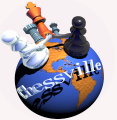1.c4 e6 2.Nc3 d5
3.d4 Be7
The Queen's Gambit
Declined.
4.Nf3 Nf6 5.Bg5
0–0 6.e3 h6 7.Bh4 b6
































































"The
Tartakower-Makogonov-Bondarevsky Variation.... It is one of
Spassky's favourites and we had been expecting him to use it long
before now, especially since Bondarevsky is his second here."-Keene
8.Rc1
''After 8.cxd5 Nxd5 9.Bxe7
Qxe7 10.Nxd5 exd5 11.Be2 Be6 12.0–0 c5 Black is left with hanging
pawns in the centre, but his position is very active. With the
useful waiting move in the game White defers the exchanging operations
in the centre, waiting for the Black bishop to go to b7, where it will
not be as well placed as at e6, and it may even prove to be a tactical
weakness in Black's position... In my 1971 match against Yefim
Geller I continued 8.Be2. Which of these moves is better is not
clear to me to this day." - Korchnoi
8...Bb7 9.Bxf6
Bxf6 10.cxd5 exd5 11.b4 c6
































































11...c5 12.bxc5 bxc5 is
more energetic according to Kasparov who offers the following
variations:
A)
13.Qb3 Bc6!
B) 13.Bb5 Na6!
C) 13.dxc5 Nd7 14.Nb5 Rc8!
But Korchnoi
does not agree. In his view
Black is faced with
resolving a mass of problems
after
13. Rb1 Qa5 14.Qd2±
12.Be2
In the 11th game Korchnoi
played 12.Bd3, and he was outplayed in the middle game by Spassky.
But the defeat was not on account of the opening.
12...Nd7
''12...Qd6 is better,
reminding White of the weakness of his b-pawn, and of the fact that
the best place for his rook is at b1.'' - Korchnoi.
If this is indeed the case,
perhaps White should not have played 8.Rc1. Instead he could
have played 8.Be2 or 8.Qc2-NSH
13.0–0 a5
































































''A sharp move.
Obviously, 13...b5 (with the idea of transferring the knight to c4)
did not appeal to Black. 14.a4 a6 15.a5 Be7 16.Rb1, and White
will soon play his knight from f3 to c5.
The quiet continuation
13...Re8 14.Qb3 Nf8 followed by ...Ne6 also seemed to my opponent to
be not altogether satisfactory in view of 15.b5. If White is
allowed to exchange on c6, then the d5 pawn will be weak, while after
15.b5 c5 16.dxc5 bxc5 17.Rfd1 Bxc3 18.Qxc3 Ne6 an unclear position
arises with ...roughly equal chances, but it too did not greatly
appeal to Spassky.'' - Korchnoi
14.b5 c5
15.dxc5! Nxc5
Not 15...Bxc3?16.c6!
16.Nd4 Qd6
17.Bg4!?
































































A subtle move preventing
occupation of c-file by the Black rooks. - NSH
"The routine 17.Bf3 Rfd8
and ...Rac8 would have led to a complicated struggle where Black's two
bishops would have compensated for the weakness of the isolated
d-pawn." -Kasparov
17...Rfd8 18.Re1
With the idea of Re2-d2.
18...Ne6
Ambitious play. Black
challenges the pride of White's position, the knight on d4.
Another way to equalize would have been 18...Ne4.
19.Bxe6!?
19.Nce2 Rac8= only draws.
19...fxe6 20.Nc6
Bxc6 21.bxc6
































































21...Bxc3?
''I will disclose a secret
to the reader: the idea thought up on the 19th move was more or less
bluff! 21...Qxc6 22.Ne4 Qb7! (the
only move to defend the 7th rank and the b-pawn)
(22...Qd7
23.Nxf6+ gxf6 24.Qd4!±)
23.Nxf6+ gxf6 24.Qg4+ Kf7 since after
25.Qf4 e5
(In
my opinion
25...Rac8!
26.Qxh6 Rh8 27.Qf4 Rxc1 28.Rxc1 Re8=
is more solid. -
Kasparov)
26.Qxh6?? Rh8!–+
































































Analysis Diagram: after
26...Rh8
White loses his queen.
25.Qh5+ Kg7= would have led
to a draw, but there was also a psychological consideration: I sensed
that Spassky liked his position, that he was prepared play for win,
and that he was unlikely to resign himself to the need to agree to a
quick draw!" - Korchnoi
22.Rxc3 Rac8
23.Qc2 e5?
































































A weak move. White's
passed pawn should have been blocked by 23...Rc7. In this case
too White would have stood better in view of his strong passed pawn,
and also the slight weakness of the Black king's position, but Black
could have defended. - Korchnoi
After 23…Qc7 White only
needs to avoid the trap, 24.Qg6?
24...Rd6 25.Rec1 e5!
Otherwise he has two promising continuations according to Kasparov:
A) 24.a4 Rd6
25.Rc1 e5 26.Qb3 and
the c6-pawn continues to be a thorn in Black's flesh according to
Kasparov.
B) 24.Rb1 Rb8 25.Rb5 e5
26.Qb3 Rxc6 27.Rxc6 Qxc6 28.Rxd5 Kh8 29.g3± White has a slight
but enduring advantage in view of the chronic weakness of the enemy
pawns. - Kasparov
24.c7 Rd7 25.Rc1
d4 26.Rc6 Qd5 27.Qb1!
Not 27.Rxb6? Rdxc7 28.Qxc7
Rxc7 29.Rxc7 Qxa2 30.h3 d3 31.Rd6 e4–+ - Keene
27...d3
If 27...b5? 28.e4! Qf7
29.Qxb5; Or 27...dxe3? 28.fxe3 b5 29.Rb6 Rdxc7 30.Rxc7 Rxc7 31.Rb8++-
28.Qxb6 d2?!
































































Korchnoi does not comment
on this move. ''It is hard to refrain from such a move, the pawn
approaches the queening square with gain of tempo! But this would
appear to be the decisive mistake. Black should not have blocked
the 2nd rank.'' - Kasparov
28...Qxa2! was essential. 29.h3!
(29.Qb7? Rf8 30.h3 Qxf2+ 31.Kh2 d2 32.Rd1 Qxe3 33.c8Q Rxb7 34.Qxb7
Qf4+ 35.Kg1 Qe3+ 36.Kh2 Qf4+=
Donev in ChessBase.)
29...Rf7 30.Qa6 Qxf2+ 31.Kh2 Qf5 32.e4! Qf4+
33.Kh1 Rff8
(33...Rfxc7?34.Qc4+ Or 33...Rcxc7?34.Rxc7 d2
35.Rc8+ Kh7 36.Rd1)
34.Qxd3 Kh7 35.Qc4±
"Black's trump card (his
d-pawn) has disappeared, whereas White's trump (his c-pawn) has
remained and although with the queens and four rooks on the board,
Black could still have hoped for counterplay involving the advance of
the a-pawn, he would have faced a difficult struggle for a draw."
- Kasparov
29.Rd1 Qxa2
If 29...Qd3? 30.Qb7 Qe2
31.Qxc8+ Kh7 32.h3 Qxd1+ 33.Kh2 Rf7 34.Qd8!+- - Korchnoi
What if the Black rook
liquidates the pawn on c7 with 34...Rxc7? 35.Qd3+! Kh8 36.Rxc7 Qc1
37.Rd7 d1Q
(Or
37...e4 38.Rd8+ Kh7 39.Qxe4+ g6 40.Qe7# )
38.Rd8# !-NSH
Kasparov offers a more
elegant line in this variation. In stead of 32.h3,White should play
32.Qh8+! Kxh8 33.Rxh6+! gxh6 34.c8Q+ Kg7 35.Qxd7+
and Qxd2 wins.
30.h3!
































































One of the greatest moves
ever played. Korchnoi wins a tempo by safeguarding the king
against all back rank threats. Spassky had set a brilliant trap.
30.Qb7? Qa4!! (Not
30...Qa1? 31.Qxc8+ Kh7 32.Qh8+ Kxh8 33.Rxh6+! (33.c8Q+ Kh7)
33...gxh6 34.c8Q+ Kg7 35.Qxd7++-) 31.Qxc8+ Kh7
(Not 32.Qg8+? Kxg8 33.c8Q+ Kh7 34.Rc2
(34.Rxd2 Qd1+!
35.Rxd1 Rxd1#
#-Keene.)
34...Qa1–+)
32.h3! Qxc6 33.Rxd2 Qc1+ 34.Kh2 Qxd2 35.Qb8 Rxc7
36.Qxc7=
30...Qa4
"After this move
grandmaster Kavalek said that White was busted, in fact he is
winning." - Keene
31.Rxd2! Rxd2
32.Qb7! Rdd8
32...Rxc7 does not save
Black.33.Rxc7 Qa1+ 34.Kh2 e4 35.Rc8+ Kh7 36.Qxe4+ g6 37.Rc7++ -
Keene
33.cxd8Q+ Rxd8
34.Rc7 Qa1+ 35.Kh2 e4 36.Qxe4 Qf6
































































The a5 pawn cannot be
saved. 36...a4 37.Ra7 Qb2 38.f4 a3 39.Qe7 The Black rook cannot
leave the 8th rank on account of Qe6+ with mate, and so the a3 pawn is
lost.
37.f4 Qf8
“The opponent might just
blunder, and allow the rook to be posted at a8!” - Korchnoi
38.Ra7
''White
does not blunder... '' - Korchnoi
38...Qc5?!
Black could have offered a
more tenacious resistance by 38...Re8! according to Korchnoi. He
offers three little variations:
A) 39.Qd4 Qf6
B) 39.Qd3
Qc5
C) 39.Qf3 Qf5
However, Kasparov
recommends
39.Qc6! Kh7
40.Qc3+-
39.Qb7 Qc3
40.Qe7 Rf8 41.e4! Qd4
Not 41...Rxf4? 42.e5!+-
42.f5
































































The sealed move. Now
that White's f-pawn is protected he threatens 43.Rxa5. - Keene
42...h5
If 42...Qc3? 43.e5!+-; Or
42...a4 43.Rd7 Qf6 44.Qxf6 Rxf6 45.Ra7 Rb6 46.Rxa4 or even
46.Kg3 +-
43.Rxa5 Qd2
44.Qe5 Qg5 45.Ra6 Rf7 46.Rg6 Qd8 47.f6 h4??
47...Rxf6 48.Qxh5+-
48.fxg7+- 1–0


 When
the Russian Team Championship commenced in Sochi last April, some of the
participants were in for a shock. The luck of the tournament pairings
brought each of them face to face with the old war lord, Victor Korchnoi.
When
the Russian Team Championship commenced in Sochi last April, some of the
participants were in for a shock. The luck of the tournament pairings
brought each of them face to face with the old war lord, Victor Korchnoi. This
book bears testimony to the old warrior’s intense passion for the game and
his incredible fighting spirit.
This
book bears testimony to the old warrior’s intense passion for the game and
his incredible fighting spirit.








